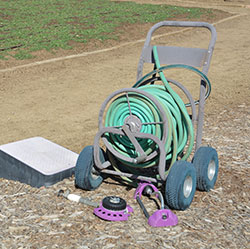Should I water my Colorado lawn in the fall?
Conventional thinking is that because evapo-transpiration (ET) rates are low and the turf isn’t growing much, it is OK to stop watering. However, historic ET and rainfall data for most of Colorado shows a need of 0.5 to 1.0 inches of irrigation per week during September and October.

Does grass grow in the fall?
While mowing isn’t needed as frequently during fall, the turf does continue to grow – but in ways that differ from spring and summer. Turfgrasses form tillers (side shoots) and rhizomes that increase the density of fall turf. This is an important time for turf to “heal” after a stressful summer, especially if it has been worn down by traffic or suffered from disease or insect problems.
Why is fall watering important?
Fall watering is essential for late season nitrogen applications to work most effectively. Fertilizer applied to dry turf is less likely to enhance fall rooting and increase energy storage.
Is the fall a good time to battle yard weeds?
Fall is the best time of year to control perennial broadleaf weeds – dandelion, clover, bindweed, plantain, and thistle, to name a few. Fall herbicide applications are more effective when applied to healthy, green, actively growing weeds. The herbicide is more easily absorbed and translocated to weed roots resulting in better control.
Does fall watering discourage mites?
Fall watering of lawns that were damaged by winter mites (clover mites, Banks grass mites) is essential for discouraging mite activity this upcoming winter and reducing potential mite problems.
For more information, see the following Planttalk Colorado™ script(s).



